
Hãy nhập câu hỏi của bạn vào đây, nếu là tài khoản VIP, bạn sẽ được ưu tiên trả lời.


Câu 10:
a: ĐKXĐ: \(\left\{{}\begin{matrix}x\notin\left\{2;-1\right\}\\y\ne-5\end{matrix}\right.\)
\(A=\dfrac{y+5}{x^2-4x+4}\cdot\dfrac{x^2-4}{x+1}\cdot\dfrac{x-2}{y+5}\)
\(=\dfrac{y+5}{y+5}\cdot\dfrac{\left(x^2-4\right)}{x^2-4x+4}\cdot\dfrac{x-2}{x+1}\)
\(=\dfrac{\left(x^2-4\right)\cdot\left(x-2\right)}{\left(x+1\right)\left(x^2-4x+4\right)}\)
\(=\dfrac{\left(x+2\right)\left(x-2\right)\cdot\left(x-2\right)}{\left(x+1\right)\left(x-2\right)^2}=\dfrac{x+2}{x+1}\)
b: \(A=\dfrac{x+2}{x+1}\)
=>A không phụ thuộc vào biến y
Khi x=1/2 thì \(A=\left(\dfrac{1}{2}+2\right):\left(\dfrac{1}{2}+1\right)=\dfrac{5}{2}:\dfrac{3}{2}=\dfrac{5}{2}\cdot\dfrac{2}{3}=\dfrac{5}{3}\)
Câu 12:
a: \(A=\dfrac{x}{x+3}+\dfrac{2x}{x-3}+\dfrac{9-3x^2}{x^2-9}\)
\(=\dfrac{x}{x+3}+\dfrac{2x}{x-3}+\dfrac{9-3x^2}{\left(x+3\right)\left(x-3\right)}\)
\(=\dfrac{x\left(x-3\right)+2x\left(x+3\right)+9-3x^2}{\left(x+3\right)\left(x-3\right)}\)
\(=\dfrac{x^2-3x+2x^2+6x+9-3x^2}{\left(x+3\right)\left(x-3\right)}\)
\(=\dfrac{3x+9}{\left(x+3\right)\left(x-3\right)}=\dfrac{3\left(x+3\right)}{\left(x+3\right)\left(x-3\right)}=\dfrac{3}{x-3}\)
b: Khi x=1 thì \(A=\dfrac{3}{1-3}=\dfrac{3}{-2}=-\dfrac{3}{2}\)
\(x+\dfrac{1}{3}=\dfrac{10}{3}\)
=>\(x=\dfrac{10}{3}-\dfrac{1}{3}\)
=>\(x=\dfrac{9}{3}=3\left(loại\right)\)
Vậy: Khi x=3 thì A không có giá trị
c: \(B=A\cdot\dfrac{x-3}{x^2-4x+5}\)
\(=\dfrac{3}{x-3}\cdot\dfrac{x-3}{x^2-4x+5}\)
\(=\dfrac{3}{x^2-4x+5}\)
\(x^2-4x+5=x^2-4x+4+1=\left(x-2\right)^2+1>=1\forall x\) thỏa mãn ĐKXĐ
=>\(B=\dfrac{3}{x^2-4x+5}< =\dfrac{3}{1}=3\forall x\) thỏa mãn ĐKXĐ
Dấu '=' xảy ra khi x-2=0
=>x=2

a) Xét \(\Delta ABH\) và \(\Delta AKC\) có:
+ \(\widehat{BAH}=\widehat{CAK}\left(gt\right)\)
+ \(\widehat{AHB}=\widehat{ACK}\left(=90^o\right)\)
=> \(\Delta ABH\sim\Delta AKC\left(g-g\right)\) abc
=> \(\dfrac{AB}{AK}=\dfrac{AH}{AC}\) (2 cặp cạch tương ứng)
=> AB.AC = AK.AH
b) Gọi I là giao điểm của BC và AK
Có \(\Delta ABH\sim\Delta AKC\)
=> \(\widehat{ABH}=\widehat{AKC}\) (2 góc tương ứng)
hay \(\widehat{ABI}=\widehat{IKC}\)
Xét \(\Delta ABI\) và \(\Delta CKI\) có:
+ \(\widehat{ABI}=\widehat{IKC}\)
+ \(\widehat{AIB}=\widehat{CIK}\) (2 góc đối đỉnh)
=> \(\Delta ABI\sim\Delta CKI\left(g-g\right)\)
=> \(\dfrac{AI}{CI}=\dfrac{BI}{KI}\) (2 cặp cạnh tương ứng)
Xét \(\Delta AIC\) và \(\Delta BIK\) có:
\(+\dfrac{AI}{CI}=\dfrac{BI}{KI}\)
+ \(\widehat{AIC}=\widehat{BIK}\) (2 góc đối đỉnh)
=> \(\Delta AIC\sim\Delta BIK\left(c-g-c\right)\)
=> \(\widehat{IAC}=\widehat{IBK}\) (2 góc tương ứng)
=> \(\widehat{IBK}=\widehat{BAH}\)
Mà \(\widehat{BAH}+\widehat{ABH}=90^o\)
=> \(\widehat{ABH}+\widehat{IBK}=90^o=>\widehat{ABK}=90^o\)
Xét tứ giác ABKC có:
\(\widehat{ABK}+\widehat{ACK}+\widehat{BAC}+\widehat{BKC}=360^o\)
=> \(\widehat{BAC}+\widehat{BKC}=180^o\)


2: Xét ΔABC có
M là trung điểm của AB
N là trung điểm của AC
Do đó: MN là đường trung bình của ΔABC
Suy ra: MN//BC
Xét tứ giác BMNC có MN//BC
nên BMNC là hình thang
mà MC=BN
nên BMNC là hình thang cân


a, \(\dfrac{2^3-x^3}{x\left(x^2+2x+4\right)}\) = \(\dfrac{\left(2-x\right)\left(x^2+2x+4\right)}{x\left(x^2+2x+4\right)}\) = \(\dfrac{2-x}{x}\)=\(\dfrac{x-2}{-x}\)(đpcm)
b, \(\dfrac{-3x\left(x-y\right)}{y^2-x^2}\) (\(x\) \(\ne\) \(\pm\) y)
= \(\dfrac{-3x\left(x-y\right)}{\left(y-x\right)\left(y+x\right)}\)
= \(\dfrac{3x\left(y-x\right)}{\left(y-x\right)\left(y+x\right)}\)
= \(\dfrac{3x}{x+y}\) (đpcm)

a) \(\dfrac{A}{x-2}=\dfrac{x^2+3x+2}{x^2-4}\)
\(\Leftrightarrow\dfrac{A}{x-2}=\dfrac{\left(x+2\right)\left(x+1\right)}{\left(x-2\right)\left(x+2\right)}\)
\(\Leftrightarrow\dfrac{A}{x-2}=\dfrac{x+1}{x-2}\Leftrightarrow A=x+1\)
b) \(\dfrac{M}{x-1}=\dfrac{x^2+3x+2}{x+1}\)
\(\Leftrightarrow\dfrac{M}{x-1}=\dfrac{\left(x+1\right)\left(x+2\right)}{x+1}\)
\(\Leftrightarrow\dfrac{M}{x-1}=x+2\Leftrightarrow M=\left(x-1\right)\left(x+2\right)=x^2+x-2\)

3) \(\sqrt{\left(x-2\right)\left(x+1\right)}\) thì (x-2)(x+1)>0
=> x2 -x-2>0
=> x2 - x - \(\dfrac{1}{2}\)- \(\dfrac{3}{2}\)>0
= (x+\(\dfrac{1}{4}\))2 - 3/2 >0
=> x+ 1/4>3/2
=> x>5/4
4) Có x đâu mà tìm bạn??

Câu 4:
\(x^6-1=\left(x^2-1\right)\left(x^4+x^2+1\right)⋮x^4+x^2+1\)
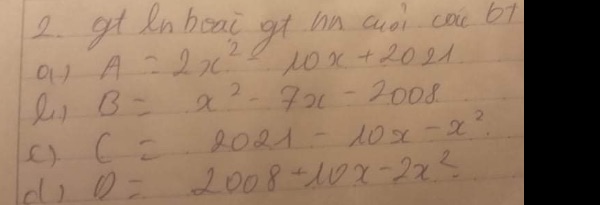
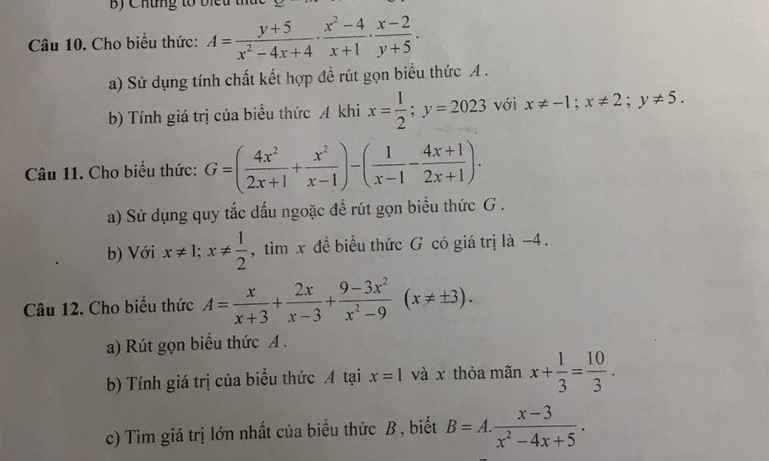


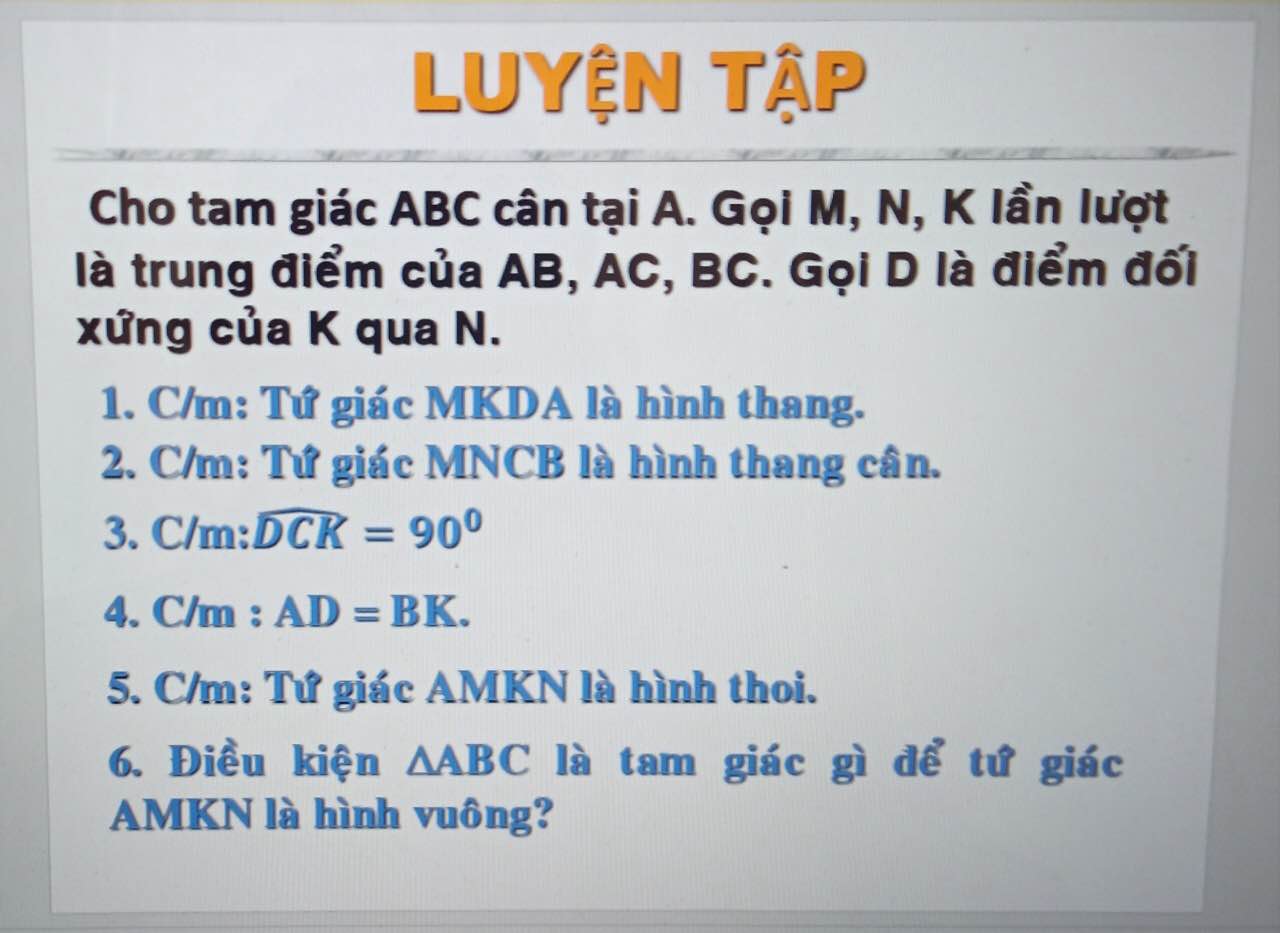 Giải giúp em bài này với mọi người 😭
Giải giúp em bài này với mọi người 😭
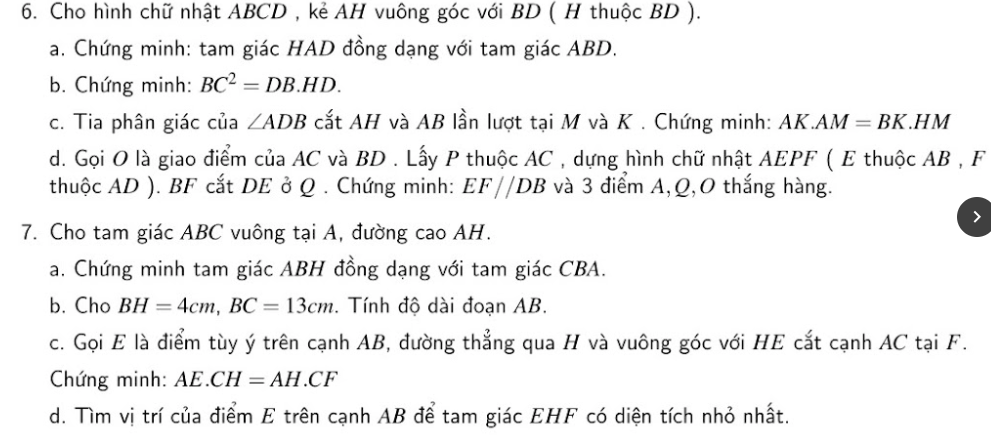

 mọi người giải giúp em bài này với ạ em đang cần gấp ạ
mọi người giải giúp em bài này với ạ em đang cần gấp ạ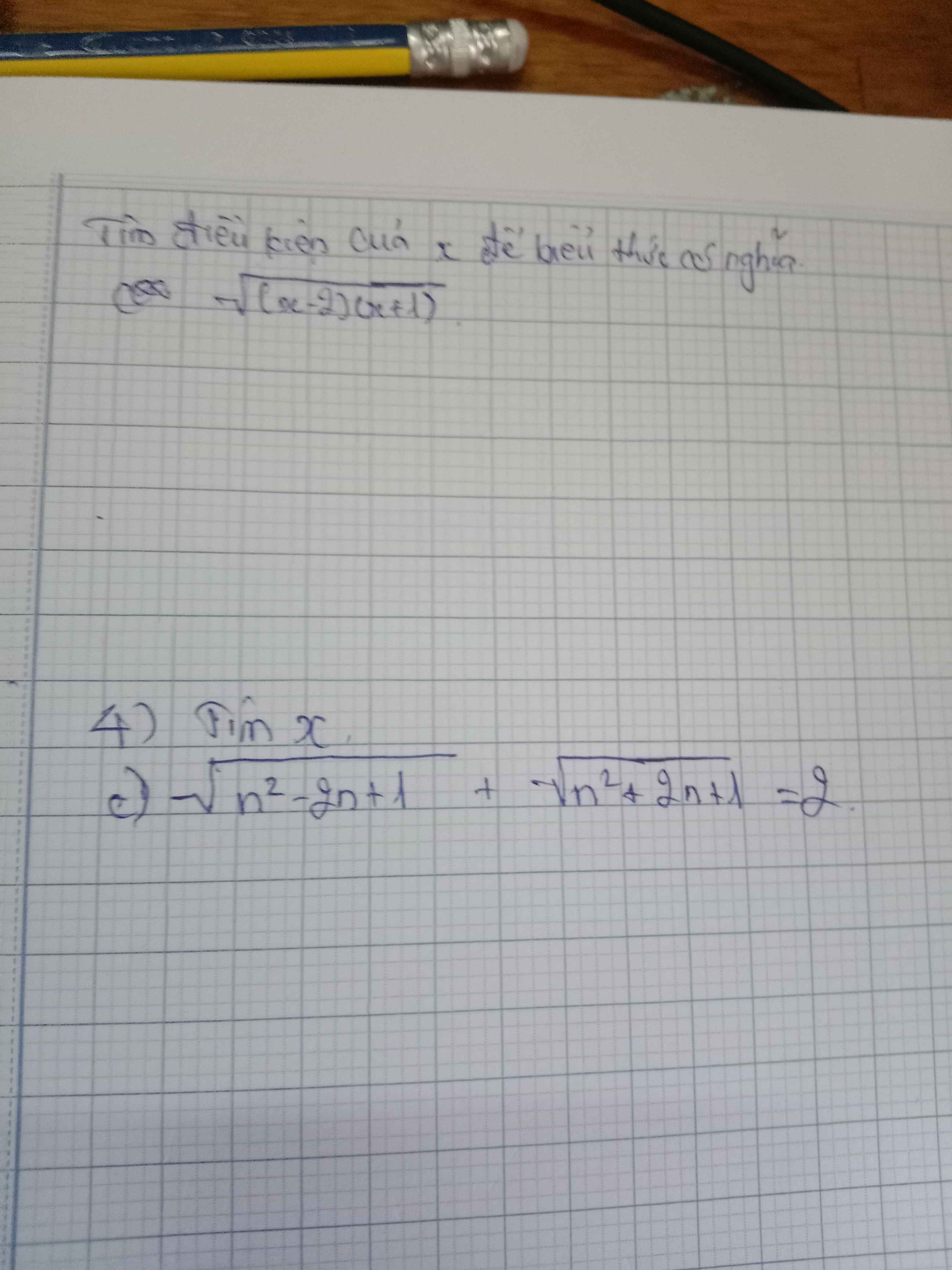
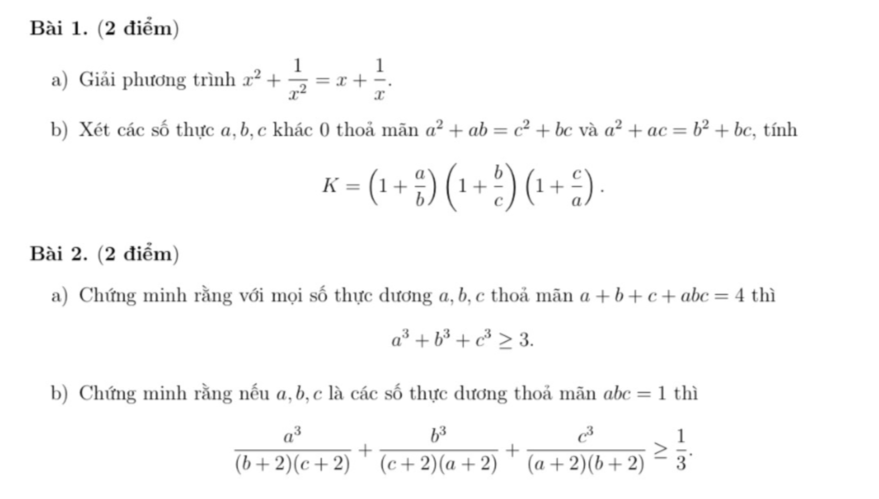


a) \(A=2x^2-10x+2021=2\left(x^2-5x+\frac{25}{4}\right)+\frac{4017}{2}\)
\(=2\left(x-\frac{5}{2}\right)^2+\frac{4017}{2}\ge\frac{4017}{2}\)
Dấu \(=\)khi \(x-\frac{5}{2}=0\Leftrightarrow x=\frac{5}{2}\)
b) \(B=x^2-7x-2008=x^2-7x+\frac{49}{4}-\frac{8081}{4}=\left(x-\frac{7}{2}\right)^2-\frac{8081}{4}\ge-\frac{8081}{4}\)
Dấu \(=\)khi \(x-\frac{7}{2}=0\Leftrightarrow x=\frac{7}{2}\)
c) \(C=2021-10x-x^2=-\left(x^2+10x+25\right)+2046=-\left(x+5\right)^2+2046\le2046\)
Dấu \(=\)khi \(x+5=0\Leftrightarrow x=-5\).
d) \(D=2008+10x-2x^2=-2\left(x^2-5x+\frac{25}{4}\right)+\frac{4041}{2}=-2\left(x-\frac{5}{2}\right)^2+\frac{4041}{2}\le\frac{4041}{2}\)
Dấu \(=\)khi \(x-\frac{5}{2}=0\Leftrightarrow x=\frac{5}{2}\).